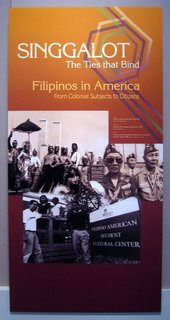 One week from today, the United States of America will celebrate Independence Day. The Philippines also used to celebrate its independence on the same day. But not anymore.
One week from today, the United States of America will celebrate Independence Day. The Philippines also used to celebrate its independence on the same day. But not anymore.This year marks the 100th year of the arrival of the first group of Filipino sakadas in Hawaii. To commemorate the event, the Smithsonian's Ripley Center came up with "Singgalot: The Ties that Bind," an exhibition that
explores the challenges and issues that confronted Filipinos from the annexation of the Philippines as a U.S. colony in 1898 to their struggles to acquire full U.S. citizenship during the 20th century.The exhibit will run in Washington, DC, until 20 August 2006. I don't know what language the word "singgalot" came from, but it doesn't seem to be a Tagalog term. And no, I don't think it's another way of saying sing-a-lot =)
There is a website that allows you to view the 30 panels in the exhibition, but while clicking on each panel leads to a larger image, these are not big enough to read the text. And that's why I've uploaded the photos I took while I was at the exhibit.
Click on the photos below if you want to read the text. If you're using Internet Explorer, after the larger image appears, point your mouse at the photo, wait until a small box appears in the lower right corner, and click on that to see the full photo. If you're using Firefox, after the larger image appears, all you have to do is click on the photo =)
If you're not good at geography, the panel on the left will help you understand just how far the Philippines is from the United States. The center panel indicates how many Filipino-Americans are in the different states, and while California and Hawaii are quite obvious, Illinois was a bit of a surprise. The panel on the right is significant because while it gets the facts right, it never mentions the term "Philippine revolution."The three panels above trace the progression of the status of Filipino immigrants from "labor recruits" to "war brides" to "skilled workers." If you don't want to—or can't—read the text, just look at the photos to see what I mean.The two panels above reflect the change in status that Filipino-Americans have achieved over the years. The left panel reproduces the photo of the entrance to a hotel in the 1930s (it says, "Positively No Filipinos Allowed"), while the right panel shows photos of an Eliseo Silva mural, Jacky Agtuca, NVM Gonzales, Lt. Gen. Antonio Taguba, Jessica Hagedorn, Venancio Igarta, Cristeta Comerford and Cheryl Diaz Meyer. Nope, sorry, Jasmine Trias wasn't part of the exhibit =)I wasn't really able to celebrate Philippine independence day last June 12, except through this post, but it will be impossible to miss the fireworks here in Boston, the "official headquarters for America's biggest Independence Day party," on July 4. I don't know how the Filipino-Americans featured in Singgalot felt on their first Independence Day in the US, but I certainly will have mixed feelings =)
Category: The Philippines
Category: The Philippines











